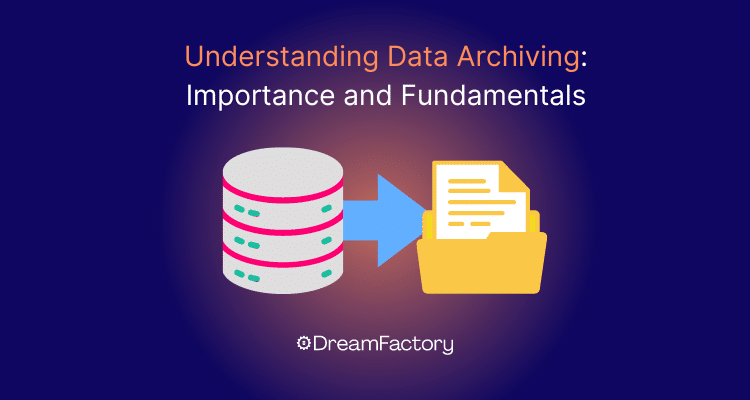Understanding Data Archiving: Importance and Fundamentals
by Spencer Nguyen • April 25, 2024

For businesses and organizations of all sizes, data archiving is a critical but often underappreciated process that leadership and IT professionals need to prioritize.While moving inactive data from primary storage to long-term archival systems may seem like a back-office operational task, it has strategic importance. Archiving is essential for remaining compliant with data retention regulations like HIPAA, SOX and GDPR, which can carry heavy fines and legal risks if mishandled.
This article explores the importance of data archiving, outlines effective strategies, and addresses the challenges businesses face in maintaining robust archiving systems.
Here’s the key points from this article:
- Data archiving is essential for compliance, cost management, and efficient data organization, ensuring long-term retention of inactive but important data.
- Compliance with regulations like HIPAA, SOX, and GDPR necessitates specific data retention periods, which archiving helps manage systematically to avoid legal penalties.
- Archiving reduces costs by transferring data from expensive primary storage to more economical, long-term solutions, decreasing the volume of data that requires regular backup.
- Effective data archiving strategies include developing clear policies, managing data lifecycles, and implementing automation to ensure data is archived consistently and efficiently.
- By enhancing data accessibility and security, archiving supports risk management by protecting archived data from loss, corruption, or breaches and by making it easier to retrieve when necessary.
Table of Contents

Generate a full-featured, documented, and secure REST API in minutes.
Generate a full-featured, documented, and secure REST API in minutes.
What is Data Archiving?
Data archiving is the process of moving data that is no longer actively used to a separate storage device for long-term retention. Rather than keeping every annual report, obsolete database and old email thread taking up precious space on expensive primary storage, archiving lets you move that inactive stuff to cheaper, long-term storage built for retention.
The primary goal of data archiving is to save storage space, improve system performance, and maintain data safely over a long period. Below, we explore the various aspects of why data archiving is crucial for businesses across all sectors.
Compliance and Regulatory Requirements
Different industries are subject to varying regulations that mandate the retention of electronic records for a specified period. For instance:
- In healthcare, the Health Insurance Portability and Accountability Act (HIPAA) requires the retention of patient records for at least six years from the date of its creation or the date when it was last in effect, whichever is later.
- Financial institutions in the United States are governed by the Sarbanes-Oxley Act (SOX), which mandates the retention of financial records and audit records for seven years.
- The GDPR in Europe imposes requirements on data retention such that data should not be held for longer than necessary but also mandates that certain records, like those pertaining to contract processing and employee information, be kept for specific periods.
- Compliance with these regulations is not optional; failure to comply can result in hefty fines, legal challenges, and damage to a company’s reputation. Data archiving helps organizations adhere to these legal requirements systematically and efficiently.
Cost Efficiency
Keeping all your company's data piled up on those pricey primary storage systems is a great way to bust your IT budget. The per-gigabyte costs for those high-performance drives add up fast when you're storing years' worth of old files and backups that nobody actively uses anymore. By archiving, businesses can unclutter those expensive legacy systems and move that inactive data to much cheaper long-term archival storage.
Data Archiving Strategies
Effective data archiving strategies are really important for managing the accumulation of data over time, ensuring compliance, improving performance, and reducing costs. Here, we explore three critical aspects of archiving strategies: policy development, data lifecycle management, and automation.
Policy Development
When it comes to getting a handle on their massive data stores, organizations just can’t archive with reckless abandon. The policy should clearly define what data needs to be archived, how long it should be kept, and who can access it. Here’s a structured approach to policy development:
- Stakeholder Involvement: Include stakeholders from IT, legal, compliance, and the business units. Each brings a unique perspective on the types of data their department handles and the specific compliance requirements they face.
- Identify Data Types: Determine which types of data need to be archived, considering both operational needs and regulatory requirements.
- Define Retention Periods: Establish how long data should be stored in the archives. This will vary based on legal requirements and business utility.
- Access Controls: Specify who can access the archived data and under what circumstances. This should align with the organization's overall security and compliance policies.
- Decommissioning Data: Plan for the secure deletion of data that is no longer required for business or legal reasons.
- These guidelines help ensure that the archiving policy is comprehensive, compliant with laws and regulations, and aligned with the business objectives.
Data Lifecycle Management
Data lifecycle management (DLM) is a policy-based approach to managing the flow of an information system's data throughout its lifecycle: from creation and initial storage to the time when it becomes obsolete and is deleted. DLM integrates with data archiving in the following ways:
- Active vs. Inactive Data: DLM processes help determine when active data becomes inactive and should be moved to archive storage.
- Automated Transitions: Policies defined in DLM automate the transition of data from primary storage to archives based on age, usage, and value.
- Retention Management: Ensures compliance by automating the retention of data for required periods and safely disposing of data when it's no longer needed.
This lifecycle approach keeps data organized and accounted for, reducing the headaches, compliance risks, and ballooning storage costs that come from mismanaged data sprawling out of control. For overwhelmed IT teams, it's a more disciplined way to get a handle on the data deluge.
Automating Data Archiving
Automation plays a pivotal role in modern data archiving strategies, enhancing both compliance and efficiency:
- Scheduled Archiving: Automation tools can be scheduled to regularly move data to archive storage based on the policies established in the DLM.
- Compliance Assurance: Automation helps in enforcing compliance with regulatory requirements by systematically archiving data according to predetermined rules and schedules, reducing the risk of human error.
- Efficiency and Scalability: Automated archiving solutions scale with data growth, handling large volumes of data without additional administrative overhead.
- By automating the archiving process, organizations can ensure that data is handled consistently and in compliance with policy and regulatory requirements, freeing up valuable IT resources and minimizing the risk of compliance violations.
Implementing these strategic elements forms the backbone of a sound data archiving strategy that supports organizational needs and compliance requirements while managing data efficiently throughout its lifecycle.
Data Management and Accessibility
Archiving helps in organizing data more effectively. It segregates active and inactive data, which simplifies data management and improves the performance of the primary storage system. Well-organized data archives equipped with indexing and search functionalities make it easier to retrieve data when needed. This accessibility is crucial for organizations that may need to access archived data for audits, legal cases, or business analysis without disrupting everyday business operations.
Risk Management
Archiving plays a critical role in risk management strategies related to data protection. By securely storing data in a controlled environment, archiving reduces the risk of data loss due to hardware failure, data corruption, or cyber-attacks on primary systems. Since archival systems can be isolated from the main network or made immutable, the data contained within is less susceptible to attacks. Additionally, many data archiving solutions offer robust security features such as encryption, ensuring data is protected both in transit and at rest, further mitigating the risk of unauthorized access and breaches.

Generate a full-featured, documented, and secure REST API in minutes.
Generate a full-featured, documented, and secure REST API in minutes.
Conclusion
Let's face it, data isn't going anywhere but up for businesses. Every year, companies collect and hoard more digital files, records, and info than the last. Trying to manage that relentless data deluge while also staying compliant with ever-shifting regulations is enough to give even the most seasoned IT pro nightmares.
That's why getting proactive with data archiving is so crucial. More than just checking some compliance box, well-designed archiving is a strategic asset that can help organizations tame their data sprawl, optimize resources, and protect vital information from threats like hardware failures or security breaches.
DreamFactory facilitates this process by providing robust tools for automating data archiving, ensuring data is handled consistently and in compliance with regulatory requirements. This proactive approach to data archiving allows businesses to safeguard their information and prepare for future challenges.
FAQ Section
What is data archiving?
Data archiving is the process of moving data that is no longer actively used to a separate storage device for long-term retention. It helps organizations manage storage costs, comply with regulations, and improve system performance by keeping inactive data accessible and secure.
Why is data archiving important?
Data archiving is crucial for several reasons: it ensures compliance with legal and regulatory requirements, enhances data management and system performance, reduces storage costs, and mitigates risks associated with data loss and breaches.
What are some common challenges in data archiving?
Common challenges include managing data format changes and technology obsolescence, ensuring scalability, navigating complex legal and compliance landscapes, and maintaining the integrity and security of archived data.
How does DreamFactory support data archiving?
DreamFactory provides tools that automate the archiving process, helping ensure that data is archived consistently and in compliance with policies and regulations. It facilitates easy integration with existing systems, allowing for seamless data management and access.
What should be considered when developing a data archiving policy?
When developing a data archiving policy, consider the types of data to archive, retention periods based on legal requirements, access controls, and plans for securely deleting data no longer required. Involvement from IT, legal, compliance, and business units is essential to address all aspects of data archiving comprehensively.
As a seasoned content moderator with a keen eye for detail and a passion for upholding the highest standards of quality and integrity in all of their work, Spencer Nguyen brings a professional yet empathetic approach to every task.
























